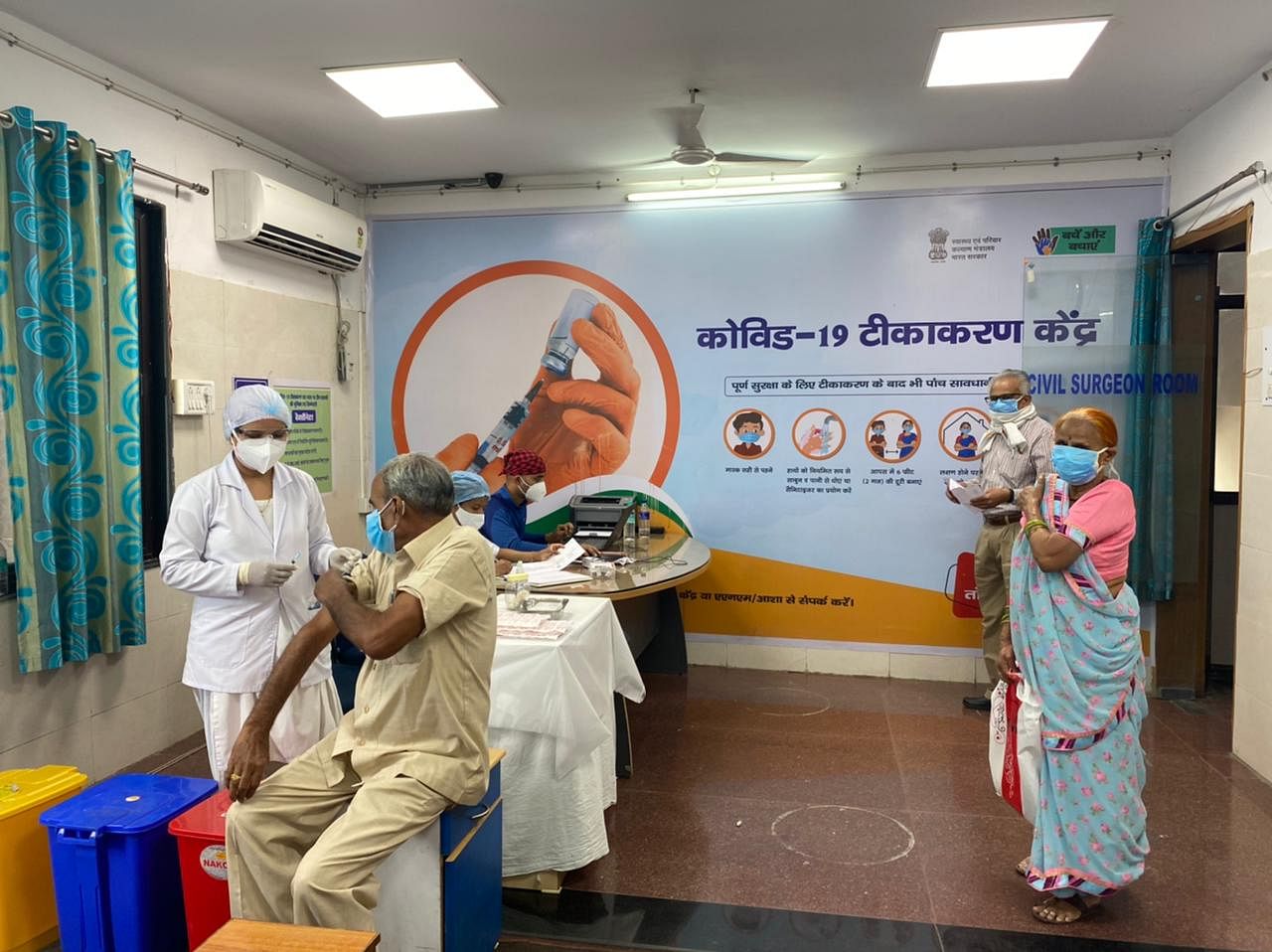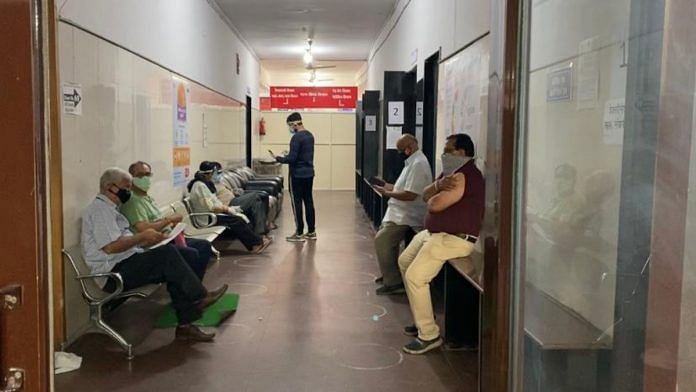Bhopal: On the first floor of the Jai Prakash District Hospital in the heart of Bhopal — one of the biggest hospitals in the capital city — the wait is not as long as it was when Ranjit Singh, a stationery shop owner, came for his first Covishield dose eight weeks ago. It took an hour then, but now it was all over in a matter of minutes. The reason, officials say, is Bhopal’s demand problem. Not hesitancy, but the vaccination drive has hit the wall of festival season and renewed lockdown restrictions.
“When we came to get the first jab, there was so much crowd. The whole room was full, there was no place to sit. Today, we just walked in and got the second dose,” Singh told ThePrint, who was accompanied by his wife.
During the first round of vaccination for those above the age of 45 with comorbidities (starting 1 March), inoculation centres were overburdened with over 500 people coming in daily. This number is now down to a little over 100, said the immunisation supervisor at the district hospital, refusing to be named.
In the days since, the number of vaccination centres has increased. In March, Bhopal had 77 vaccination centres, which have now more than doubled to over 180. Fifty-two of these are private centres. The state altogether has 4,000 vaccination centres.
Madhya Pradesh is among the eight states in the country — apart from Maharashtra, Rajasthan, Uttar Pradesh, Gujarat, West Bengal, Karnataka and Kerala — that account for almost 60 per cent of the total Covid-19 vaccines administered so far. Even so, there is now an imbalance between demand and supply of vaccines, with the latter outweighing the former.
“It is harder to inoculate people than it is to make the vaccine,” Madhya Pradesh Medical Education Minister Vishwas Sarang said. “In the first two rounds of inoculation, MP was the second best performing state in the country.”
Madhya Pradesh currently has over 82,000 active cases. It has recorded a total of 4.28 lakh Covid cases so far. On 21 April, 75 deaths were recorded, taking the state’s total Covid fatalities to 4,788.
Also Read: Between ‘Covid is over’ and universal vaccination cheer, India lost sight of strategy
Seeking help from religious, tribal leaders
To combat this gap in supply and demand, the state has undertaken a door-to-door campaign to spread awareness. “We have asked religious leaders and social workers to help spread awareness because they have a huge following. It is obvious that religious leaders have a greater impact and we have really relied on them to help spread awareness,” Sarang said.
“Our aim is to save lives. Religious leaders should take the lead at a time like this, when there is vaccine hesitancy during the festive season,” he added.
By festive season, Sarang is referring to Navratri, which started 13 April and ended 21 April, and Ramzan, which began 13 April and will continue toll 12 May. The observance of both festivals involves fasting.
Said Chhavi Bhardwaj, mission commissioner, National Health Mission, “We have learnt that people are not getting vaccinated because of the festive season. The lockdown is another reason why people are hesitant to come out and get the jab.”
Some of the worst-affected districts of Madhya Pradesh — including Bhopal, Indore and Berasia — have been under a lockdown since 13 April. The lockdown, which only allows essential services to operate, will continue till 30 April.
Dr Kamlesh Ahirwar, the district immunisation officer in Bhopal, echoes the sentiment. “There is a communication gap from the government and social sector in spreading awareness about the need to get vaccinated. Inoculating those above the age of 18 should have been opened up before 1 May,” he said.
“We have outreach camps in offices and residential areas to vaccinate people. Had there been proper awareness and demand, there would have not been any requirement for outreach camps,” he added.
Vaccine hesitancy has also been reported from the state’s tribal areas, with Bhardwaj attributing this to lack of awareness and knowledge on the process. According to the 2011 Census, Scheduled Tribes constitute 21.1 per cent of the state’s total population.
To counter this, Bhardwaj said, panchayat leaders have been engaged.
“We have approached gram panchayat and panchayat leaders to get the jab themselves and lead by example. We have involved them to help spread awareness about the need to get vaccinated,” she added.
Also Read: Rajasthan, which once topped Covid vaccination charts, is now left with stock for ‘just 3 days’
The next phase of vaccination
Of the 85 lakh doses Madhya Pradesh has received from the central government since the vaccination drive began on 16 January, a little over 75 lakh have been used.
“We have around nine lakh doses left that will last us around four-five days. We inoculate around two-three lakh people every day. Another shipment of about 10-12 lakh doses is expected by Saturday-Sunday,” Bhardwaj told ThePrint.

From 1 May, when the next phase of vaccination begins for all adults, Madhya Pradesh will receive 50 per cent of its required stock from the Government of India supply, while the rest will be procured by the state, said Bhardwaj. “Plan of action on how to immunise such a large population is yet to be finalised,” she added.
Madhya Pradesh, with a population of around 7.27 crore (2011 census), had administered a total of 75,42,949 doses till 21 April. A total of 8,17,314 people have received the second dose.
In comparison, Maharashtra, with a population of 11.24 crore, has administered a total of 1,29,45,000 doses. Uttar Pradesh, with a population of nearly 20 crore, had administered 1,11,20,780 doses by 21 April. West Bengal, with a population of 9 crore, has administered 92,11,156 doses. Bihar, with 10.41 crore people, has administered 59,65,675 doses.
On this, Bhardwaj refused to comment. However, she said, “We have a very strict definition of who we call front-line workers (FLW). It is obvious that vaccine supply is limited so we have to be discreet in defining who a FLW is. I don’t think other states are being this strict.”
(Edited by Sunanda Ranjan)
Also Read: Yogi’s Team-11 & how they are tackling Covid crisis in India’s now second worst-hit state



